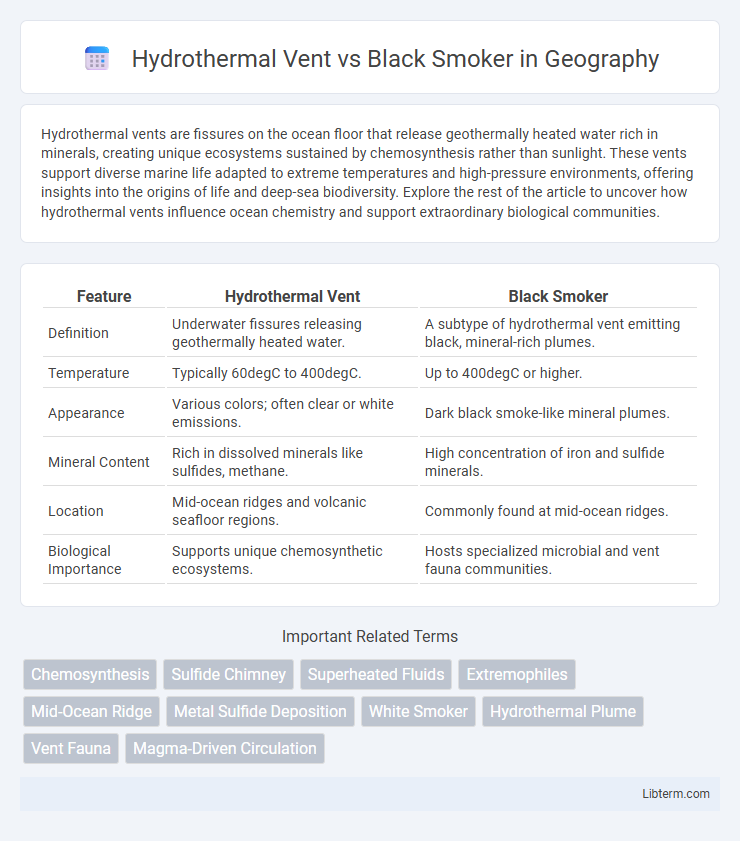Hydrothermal vents are fissures on the ocean floor that release geothermally heated water rich in minerals, creating unique ecosystems sustained by chemosynthesis rather than sunlight. These vents support diverse marine life adapted to extreme temperatures and high-pressure environments, offering insights into the origins of life and deep-sea biodiversity. Explore the rest of the article to uncover how hydrothermal vents influence ocean chemistry and support extraordinary biological communities.
Table of Comparison
| Feature | Hydrothermal Vent | Black Smoker |
|---|---|---|
| Definition | Underwater fissures releasing geothermally heated water. | A subtype of hydrothermal vent emitting black, mineral-rich plumes. |
| Temperature | Typically 60degC to 400degC. | Up to 400degC or higher. |
| Appearance | Various colors; often clear or white emissions. | Dark black smoke-like mineral plumes. |
| Mineral Content | Rich in dissolved minerals like sulfides, methane. | High concentration of iron and sulfide minerals. |
| Location | Mid-ocean ridges and volcanic seafloor regions. | Commonly found at mid-ocean ridges. |
| Biological Importance | Supports unique chemosynthetic ecosystems. | Hosts specialized microbial and vent fauna communities. |
Introduction to Hydrothermal Vents
Hydrothermal vents are fissures on the seafloor where geothermally heated water is released, creating unique ecosystems independent of sunlight. Black smokers are a type of hydrothermal vent characterized by the emission of mineral-rich, superheated water that appears black due to metal sulfide particles. These vents support diverse biological communities by providing essential chemicals for chemosynthesis, sustaining life in extreme deep-sea environments.
What Are Black Smokers?
Black smokers are a type of hydrothermal vent found on the ocean floor, characterized by their emission of superheated water rich in dissolved minerals like iron and sulfides. These vents expel dark, smoke-like plumes formed as the hot, mineral-laden water rapidly cools upon contact with the cold seawater. Black smokers play a crucial role in supporting unique deep-sea ecosystems by providing energy and nutrients through chemosynthesis.
Formation Processes Compared
Hydrothermal vents form when seawater penetrates the ocean crust, heats up by magma, and reemerges enriched with dissolved minerals and chemicals. Black smokers, a specific type of hydrothermal vent, emit superheated, mineral-rich fluids that precipitate metal sulfides, creating characteristic black plumes and chimney-like structures. The formation of black smokers relies on higher temperatures and metal concentrations compared to typical hydrothermal vents, resulting in distinct mineral deposits such as pyrite and chalcopyrite.
Chemical Composition Differences
Hydrothermal vents release mineral-rich fluids containing dissolved metals like iron, manganese, and sulfides, with a broad range of chemical compositions depending on geological settings. Black smokers are a specific type of hydrothermal vent characterized by emitting high-temperature fluids rich in dissolved metals, especially iron and sulfide minerals, which precipitate upon contact with cold seawater, forming characteristic black particulate plumes. The primary chemical difference lies in black smokers' notably higher concentrations of sulfide minerals and metals, resulting in distinct chimney structures compared to other hydrothermal vent types.
Geographical Locations and Distribution
Hydrothermal vents are found along mid-ocean ridges, subduction zones, and back-arc basins, with significant concentrations in the East Pacific Rise, Mid-Atlantic Ridge, and the Juan de Fuca Ridge. Black smokers, a specific type of hydrothermal vent characterized by high-temperature, metal-rich fluids, are predominantly located at fast-spreading centers such as the East Pacific Rise and the Mid-Atlantic Ridge. The geographical distribution of these vents reflects tectonic activity zones where seawater interacts with magmatic heat sources, supporting unique deep-sea ecosystems.
Biological Communities and Adaptations
Hydrothermal vent biological communities consist of chemosynthetic bacteria forming the base of the food web, supporting diverse organisms such as tube worms, clams, and shrimp adapted to extreme temperatures and toxic chemicals. Black smokers, a type of hydrothermal vent, emit superheated, mineral-rich fluids fostering specialized microorganisms capable of withstanding intense heat and metal concentrations, which in turn support highly adapted vent fauna. Adaptations include symbiotic relationships, heat-resistant enzymes, and unique respiratory systems enabling survival in the vent's harsh, toxic environment.
Temperature and Pressure Variations
Hydrothermal vents exhibit a wide range of temperature and pressure variations depending on their location and fluid composition. Black smokers, a specific type of hydrothermal vent, release superheated fluids typically between 350degC and 400degC under high pressure conditions found at depths around 2,000 meters or more, nearing 200 atmospheres. In contrast, other hydrothermal vents may emit cooler fluids under lower pressure, often resulting in temperatures below 300degC, reflecting differences in geological activity and fluid chemistry.
Mineral Deposits: Types and Economic Value
Hydrothermal vents produce diverse mineral deposits, including sulfides rich in copper, zinc, and lead, essential for various industrial applications. Black smokers specifically emit high concentrations of metal-rich fluids, leading to the formation of massive sulfide deposits with elevated levels of gold and silver, significantly enhancing their economic potential. These mineral-rich deposits offer critical resources for mining industries, fueling advancements in technology and infrastructure globally.
Significance in Earth's Ecosystem
Hydrothermal vents and black smokers both play crucial roles in Earth's deep-sea ecosystems by supporting unique biological communities through chemosynthesis, where microbes convert minerals and chemicals from Earth's interior into energy. Hydrothermal vents provide essential nutrients and thermal energy that sustain diverse organisms in otherwise nutrient-poor ocean depths, contributing significantly to global biogeochemical cycles, including carbon and sulfur cycling. Black smokers, a type of hydrothermal vent characterized by high-temperature mineral-rich fluids, enhance metal and mineral distribution on the seafloor, influencing local geology and fostering habitats for specialized extremophile species.
Future Research and Exploration Directions
Future research on hydrothermal vents and black smokers will emphasize advanced in-situ monitoring technologies to better understand their complex geochemical processes and microbial communities. Exploration using autonomous underwater vehicles (AUVs) equipped with high-resolution sensors aims to map vent fields and discover new locations in unexplored deep-sea regions. Integrating multi-disciplinary approaches including genomics, mineralogy, and oceanography will enhance knowledge of vent system formation, ecosystem dynamics, and their potential biotechnological applications.
Hydrothermal Vent Infographic

 libterm.com
libterm.com